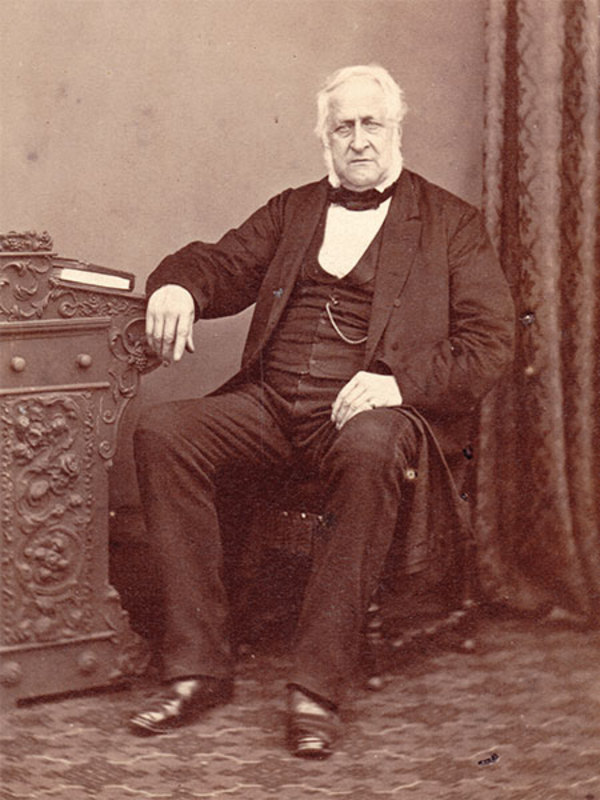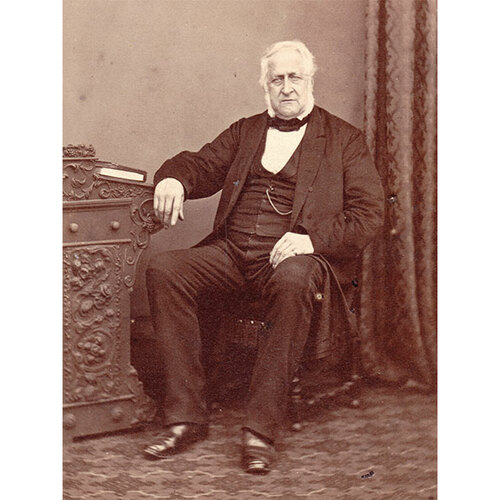
Source: Link
CALDWELL, WILLIAM BLETTERMAN, soldier and colonial administrator; b. probably in 1798; d. 29 Jan. 1882 in London, England. He is known to have married and had five children.
William Bletterman Caldwell’s family background is unknown but it may be assumed to have been English. Caldwell made the army his career, and began as ensign in the 60th Foot in September 1814. He served in various regiments during the following years, being promoted captain in 1831 and major in 1846. In September 1848 he arrived at the Red River Settlement as the officer commanding a small body of out-pensioners of the Royal Hospital, Chelsea, as well as governor of the District of Assiniboia. Caldwell was nominated for the post of governor by the colonial secretary, Lord Grey, but appointed and paid by the Hudson’s Bay Company.
The first governor not previously associated with the HBC, Caldwell was appointed in an attempt to solve the basic anomaly in the government of the colony at Red River: the HBC enjoyed a monopoly of the fur trade and at the same time appointed the members of the government and the courts. It was hoped as well that the pensioners under his command would have a stabilizing effect on the colony, made restless by the approach of American settlement and by demands from its inhabitants for self-government and free trade, but this attempt by the HBC to give the settlement an impartial government, with some force at its disposal, failed. The settlers continued to regard the governor and the Council of Assiniboia as creatures of the HBC, and the pensioners were too few in number and their habits too unmilitary to instil the respect that the previous military unit in the settlement, the 6th Foot, had imposed [see John ffolliott Crofton].
It was under these circumstances that Caldwell, as governor, had to preside over the trial of Pierre-Guillaume Sayer* in the General Quarterly Court of Assiniboia in May 1849. Sayer was a Métis who, along with three others, was charged with trading in furs with the Indians. The action was apparently instigated by John Ballenden*, HBC chief factor at Red River, in an attempt to obtain a clear judicial decision that trading in furs with the Indians by private individuals was illegal. Unfortunately for Ballenden, although Sayer was found guilty he was not sentenced; this result was interpreted by mast as freeing the trade [see Adam Thom]. The trial was, in fact, the company’s last attempt to enforce its monopoly.
Caldwell emerged from the affair with the reputation of being a weak and ineffectual governor. The Métis, led by Louis Riel* père, had attended the trial en masse and armed, yet Caldwell had not called out the pensioners to protect the court. He defended himself by arguing that he had not been given a force of 200 as promised; only 56 men, with 42 women and 57 children, had arrived in Red River in September 1848. His force, he declared, could man the walls of Upper Fort Garry (Winnipeg) but could not police the settlement. When he had inquired of the members of the Council of Assiniboia and the leading settlers if reliable men would serve as special constables, the reply had been that they would not in a matter relating to the fur trade because they feared a reaction by the Métis. He had therefore decided that calling out the pensioners could not be a success and might prove to be a provocation, a decision that demonstrates his common sense, if nothing else.
Opposition to Caldwell reached a climax in July 1850 with the celebrated Foss v. Pelly case, which arose out of rumours of an indiscretion by Sarah McLeod*, the wife of Chief Factor John Ballenden, and Captain Christopher Vaughan Foss, Caldwell’s second-in-command. The gossip increased until Foss sued Augustus Edward Pelly, the HBC accountant at Red River, and his wife, along with John Davidson, the mess steward, and his wife, for conspiracy to slander. Because all the magistrates in the settlement refused to sit with him, Caldwell was forced to hold court alone. The three-day trial which followed was a disorderly affair. When the legal complexities overcame Caldwell, he called upon Adam Thom, the recorder, to assist him. Thom, who had advised Foss and Mrs Ballenden before the case and strongly supported them, appears to have taken every opportunity to ensure Pelly’s conviction, including stepping down from the bench to testify on behalf of the plaintiff, before charging the jury. In the end, the court found in favour of Foss, and Caldwell awarded him damages.
Caldwell’s irregular handling of the trial in the Foss v. Pelly case brought to a head the dissatisfaction of the English-speaking settlers with him. Led by Alexander Ross*, 500 of them petitioned for Caldwell’s dismissal. The situation was defused when the new governor of Rupert’s Land, Eden Colvile*, arrived a month after the trial, in August 1850, took up residence in the settlement, and with Caldwell’s consent presided over council and court until quiet was restored.
Though Colvile considered him unfit to be governor, Caldwell resumed his duties in 1851 and remained in Red River until 1855 when he returned to England. He was succeeded by Francis Godschall Johnson*. Caldwell had been promoted lieutenant-colonel in 1854, and he retired from the army in 1857. He was called before the select committee of the British House of Commons held in 1857 to investigate the renewal of the HBC licence, and gave evidence favourable to the company. He died in London in 1882.
PAM, HBCA, A.11/95, 2 Aug. 1849, 24 March 1850; D.4/42, 25 June 1840; D.5/22, 26 May 1848. PRO, CO 42/608, Caldwell to Merivale, 31 March 1856. Canadian North-West (Oliver), I: 352. G.B., Parl., House of Commons paper, 1857, Report from the select committee on the HBC. HBRS, XIX (Rich and A. M. Johnson). Hart’s army list, 1846; 1854; 1857. Rich, Hist. of HBC, II: 544.
Cite This Article
W. L. Morton, “CALDWELL, WILLIAM BLETTERMAN,” in Dictionary of Canadian Biography, vol. 11, University of Toronto/Université Laval, 2003–, accessed November 22, 2024, https://www.biographi.ca/en/bio/caldwell_william_bletterman_11E.html.
The citation above shows the format for footnotes and endnotes according to the Chicago manual of style (16th edition). Information to be used in other citation formats:
| Permalink: | https://www.biographi.ca/en/bio/caldwell_william_bletterman_11E.html |
| Author of Article: | W. L. Morton |
| Title of Article: | CALDWELL, WILLIAM BLETTERMAN |
| Publication Name: | Dictionary of Canadian Biography, vol. 11 |
| Publisher: | University of Toronto/Université Laval |
| Year of publication: | 1982 |
| Year of revision: | 1982 |
| Access Date: | November 22, 2024 |



